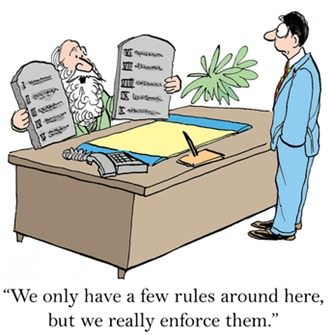The 10 Commandments For The OHS Person
Guest Post by George Robotham – and I managed to refrain from calling him the “God of Safety”. That title actually belongs to “SOTER” who was the God of safety, preservation and deliverance from harm. His female equivalent was the Goddess “SOTERIA”.
Introduction
 OHS people often complain about lack of progress in driving OHS Management and OHS Learning change. Frankly this is often because they are not particularly organised and do not use appropriate processes. The paper OHS Change Management / Project Management provides some insight.
OHS people often complain about lack of progress in driving OHS Management and OHS Learning change. Frankly this is often because they are not particularly organised and do not use appropriate processes. The paper OHS Change Management / Project Management provides some insight.
The 10 Commandments For The OHS Person
The following is a selection of techniques that have worked for me in driving significant OHS change. Use of some or all of them will assist in managing significant OHS issues.
1. Learn as much as you can about the particular issue. Google, visit a library to identify relevant texts, network with peers, examine credible sources of information (Legislation, Australian Standards, government guidelines etc.) and examine industry practice.
2. Carry out a survey to identify the workforce perception of the issue of interest. Sometimes there is value in collating the answers onto histograms, displaying the histograms to the people who completed the survey, discussing the results and trying to establish why the responses are the way they are. This is best done by as senior a managers as possible who does not react defensively to criticism.
3. Carrying out a force field analysis on the particular issue with the stakeholders may help to focus issues.
4. Carryout a needs analysis and if necessary a learning needs analysis.
5. Based on the above develop a project plan to manage the issue in association with the stakeholders. Form a project team to manage the plan. Get management approval for the plan.
6. Launch and communicate the project plan. My general advice with communication is to use face to face communication wherever possible, use the powerful influence of the work group supervisor and frame communication relevant to the work environment of the group being communicated to. High powered communications from senior management about the goals, mission, vision and the objectives of the company will not have much of an impact with many of the workers.
7. Carry out interactive learning using Action and Experiential learning models. The learning must have a focus on the reality of the workplace. My advice is to check out both the process and content of potential providers very carefully, there are some snake oil salesmen in this space. I know it is not everybody’s thing but properly structured outdoor learning experiences can be a powerful means of learning. Just ensure the focus is on the learning not the outdoor experience.
8. As a follow up to learning facilitation engage in authentic tasks / activities / projects in the workplace. Progress must be regularly discussed, reviewed and evaluated, Celebrate the success of these.
9. Meet with the people who attended the learning facilitation and discuss what is going well and what opportunities for improvement have been presented. I know it is not everybody’s thing but I encourage leaders to maintain a reflective journal about their experiences, used properly this can be a powerful means of learning.
10. Evaluate, communicate and celebrate success. Establish what was learnt in the process and how you would do it better next time.
Another version from another highly respected safety person:
Mine are more like this:
1. Learn about people and the psychology of risk. Understand why people make decisions.
2. Learn as much as you can about effective communication, Pitching, framing and priming.
3. Understand the complexities of culture, most incidents are culturally determined not behaviourally determined. The culture fosters and encourages the behaviour.
4. Don’t carry out surveys if you don’t understand survey methodology. Your conclusions and speculations will most likely be wrong and based on naivety of methodology and inexperience and poor communications knowledge.
5. Understand human decision making process, why people are motivated to do what they do, particularly the importance of the psychology and science of perception.
6. Learn how to research, chasing up Google and libraries is confined to your maturity in research skills and your ability to understand self and your own biases.
7. Investigate the nature of any incident (needs analysis) from the perspective of physical, secondary (psychological) and tertiary (cultural) perspective. If you don’t know how to do so, learn how to do these. Any analysis from just a physical, regulatory and legislative perspective will only give a systems solution.
8. Understand that leadership and learning in risk requires study and experience. If you haven’t learnt about the psychology of risk, start reading.
9. Stop listening to OHS ‘noise’. It is a distraction and delusional and creates the idea that you are actually an expert in risk and safety.
10. Understand how language shapes culture and behaviour and work hard to eliminate wrongful discourse in your workplace culture and influence the organisation to use rightful priming in talking about risk and safety.



Do you have any thoughts? Please share them below